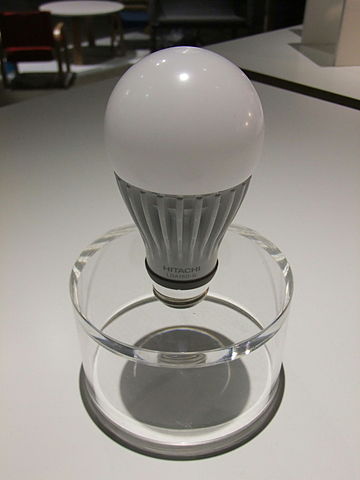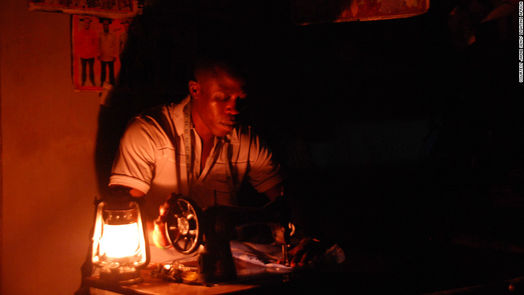Lighting: Difference between revisions
No edit summary |
m (1 revision imported) |
(No difference)
| |
Latest revision as of 01:47, 29 August 2017

Lighting is a general term that refers to the process of illuminating a home, workplace, or street to make it livable through different technologies such as light bulbs, kerosene lanterns, charcoal burners, or through daylighting. Lighting spaces uses a significant amount of energy and can release a large amount of emissions, but the amount of light that can be obtained for a certain amount of energy varies depending on the fuel used. For example, LED bulbs are far more efficient than burning biomass for light.
Lighting and Energy Use
Residential lighting uses a significant amount of energy. In Canada in 2010, 4% of residential energy use was connected to lighting.[2] Although the use of lights cannot be completely cut out, as it is necessary for comfort and functionality, it can be reduced. Lighting costs can be reduced by:[2]
- Using natural lighting when possible
- Installing more efficient bulbs (halogen, compact fluorescent, and LED bulbs all have different efficiencies)[3]
- Turning lights off when not in use
- Using controls such as timers and motion sensors to ensure lights are not on when they are not needed
- Designing and using lighting with energy efficiency considerations
The appropriate measure for lighting is lumens rather than watts. Whereas watts indicate the amount of power used by the bulb, lumens represent the amount of light provided by the bulb.[2] Comparing wattage can be misleading, as bulbs that use less energy may still provide the same amount of light (in lumens). Using lumens to compare bulbs allows for more direct comparisons of light quantity.
For more information about the efficiency of different light bulbs, see National Resources Canada's page here or this page.
Lighting in Underdeveloped Countries
Limited access to electricity in developing countries often leads to lower quality lighting. It is estimated that around 1.2 billion people worldwide do not have access to electricity in their homes,[4] many of these, approximately 95%, being people located in Africa and Asia.[5] As well, most of the people who do not have access to electricity are part of the rural population, with about 84% of people without access to electricity living in rural areas.[5] In addition to this, those who do not have access to electricity use other fuels for cooking and lighting. These fuels are less efficient, more polluting, and provide a lower quality of light. The access to non-solid fuels is important to improving lighting quality as solid fuels are some of the most polluting. In Figures 2 and 3 a comparison of the light provided from a kerosene lantern and an LED lamp are shown. It is clear that the kerosene lantern provides much poorer light which makes working, studying, and other tasks more difficult. As well, the incomplete combustion of fuels such as charcoal and kerosene results in harmful and polluting smoke that poses a significant heath risk.[6] Using these fuels increases chances of death from pneumonia, stroke, heart disease, chronic obstructive pulmonary disease (COPD), lung cancer, and other ailments.[7]
- Comparing Lighting Technologies
Figure 2. A man working by the light of a kerosene lantern. This type of lighting provides dim light that is not easy to work in. [8]
Figure 3. The same room lit by an LED lamp, providing much more light. This makes work much easier.[8]
Access to lighting is important in ensuring a satisfactory quality of life for people and promoting economic development. Increased access to high quality light improves education, entertainment, health, comfort, protection, and productivity. In a study done in the Phillipines,[9] it was determined that access to electricity provided families with improved education as children could study more easily after dark. As well, not having to collect fuels to burn saves time for people in the family, particularly the women. As well, increased access to electricity simplified household tasks and improved the productivity of home businesses. Overall, it was estimated that 1.82 years of education were added in electrified households and the monthly benefit was $10.33.[9]
References
- ↑ Wikimedia Commons. (May 27, 2015). Hitachi LED light bulb [Online]. Available: http://commons.wikimedia.org/wiki/File:Hitachi,_LED_light_bulb,_LDA15D-G,_E26_cap,.jpg
- ↑ 2.0 2.1 2.2 Natural Resources Canada. (May 27, 2015). Lighting [Online]. Available: https://www.nrcan.gc.ca/energy/products/categories/lighting/13730
- ↑ National Resources Canada. (May 27, 2015). Light Bulbs [Online]. Available: http://www.nrcan.gc.ca/energy/products/whats-new/13583
- ↑ World Bank. (May 27, 2015). Energy Overview [Online]. Available: http://www.worldbank.org/en/topic/energy/overview#1
- ↑ 5.0 5.1 International Energy Agency. (May 27, 2015). Energy Poverty [Online]. Available: http://www.iea.org/topics/energypoverty/
- ↑ The World Bank. (May 27, 2015). Tracking Access to Nonsolid Fuel for Cooking [Online]. Available: http://www-wds.worldbank.org/external/default/WDSContentServer/WDSP/IB/2014/05/15/000333037_20140515114123/Rendered/PDF/880590BRI0know00Box385214B00PUBLIC0.pdf
- ↑ The World Health Organization. (May 27, 2015). Household Air Pollution [Online]. Available: http://www.who.int/mediacentre/factsheets/fs292/en/
- ↑ 8.0 8.1 Lighting Africa (World Bank Group). (May 27, 2015). Lighting [Online]. Available: https://www.lightingafrica.org/about-us/
- ↑ 9.0 9.1 'Rural Electrification and Development in the Philippines: Measuring the Social and Economic Benefits May 2002' by Joint UNDP/World Bank Energy Sector Management Assisstnce Programme (ESMAP) available online http://siteresources.worldbank.org/INTPSIA/Resources/490023-1120845825946/philippines_rural_electrification.pdf accessed: August 17th, 2017.



